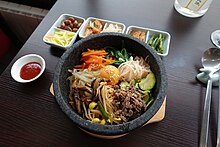Loading AI tools
Korean cookware or serveware From Wikipedia, the free encyclopedia
A dolsot (Korean: 돌솥; lit. "stone pot") or gopdolsot (곱돌솥; lit. "agalmatolite pot") is a small-sized piece of cookware or serveware made of agalmatolite, suitable for one to two servings of bap (cooked rice).[1][2][3] In Korean cuisine, various hot rice dishes such as bibimbap or gulbap (oyster rice) as well as plain white rice can be prepared and served in dolsot. As a dolsot does not cool off as soon as removed from the stove, rice continues to cook and arrives at the table still sizzling.[4]
| Dolsot / Gopdolsot | |
 Dolsot-bibimbap, bibimbap served in a dolsot | |
| Korean name | |
|---|---|
| Hangul | 돌솥 |
| Revised Romanization | dolsot |
| McCune–Reischauer | tolsot |
| IPA | [tol.sot̚] |
| Hangul | 곱돌솥 |
| Revised Romanization | gopdolsot |
| McCune–Reischauer | koptolsot |
| IPA | [kop̚.t͈ol.sot̚] |
On the bottom of a dolsot, there is a thin crust of scorched rice, to be scraped off and eaten in the case of bibimbap or made into sungnyung (숭늉, infusion) in the case of unseasoned rice dishes. In the former case, dolsot can be brushed with sesame oil beforehand to facilitate scraping.[4] To make sungnyung, the unscorched part of rice is scooped and transferred into another serving bowl right after being served, and hot water or tea (usually mild-grain teas such as barley tea or corn tea)[5] is poured into the dolsot while it is still blistering hot. The infusion with loosened chunks of scorched rice remains warm until the end of the meal, when it is typically savored.
Seamless Wikipedia browsing. On steroids.
Every time you click a link to Wikipedia, Wiktionary or Wikiquote in your browser's search results, it will show the modern Wikiwand interface.
Wikiwand extension is a five stars, simple, with minimum permission required to keep your browsing private, safe and transparent.